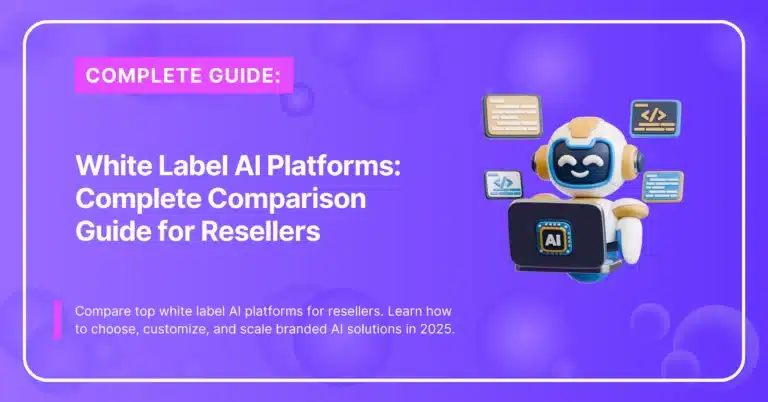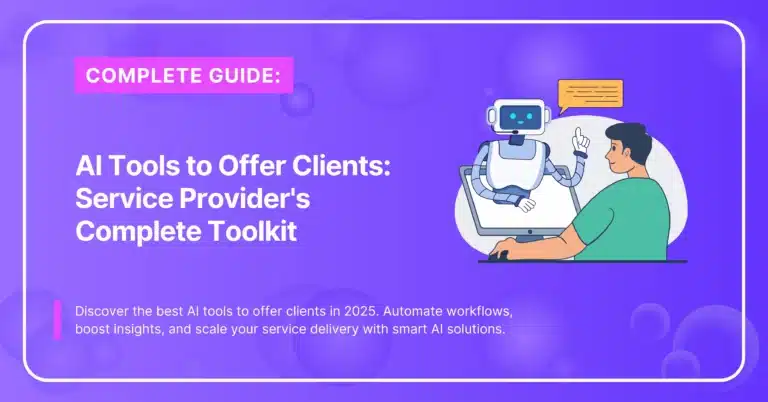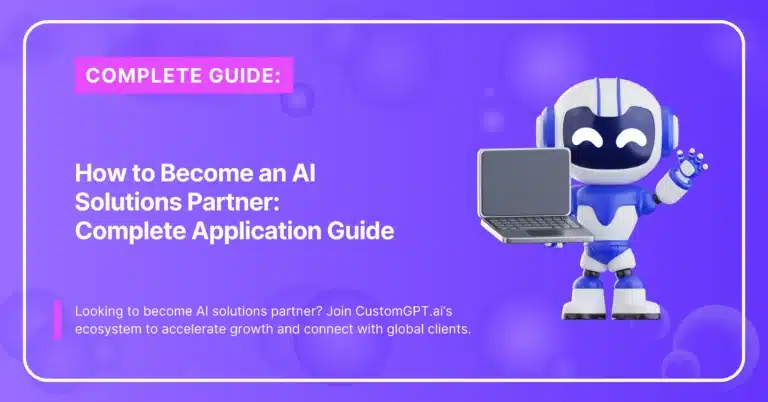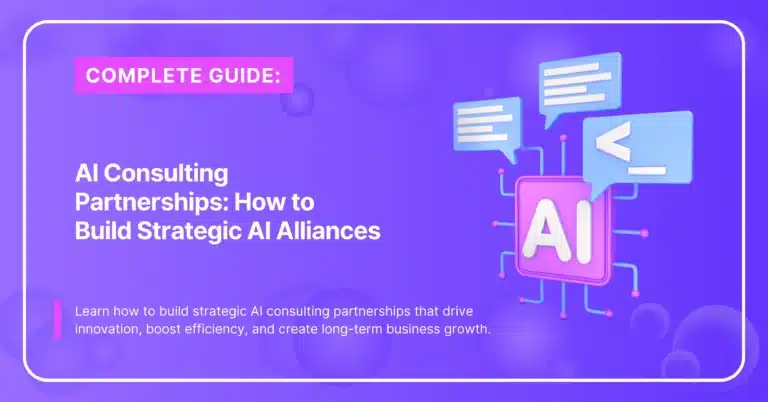AI has become the backbone of modern marketing agencies. What began as a way to automate simple tasks now shapes how campaigns are planned, executed, and measured.
For agencies, the AI opportunity is clear: deliver personalization at scale, uncover insights faster, and prove ROI with greater precision.

Make Money With AI
Join our Partner Programs!
Boost your reputation, drive revenue and grow your business with CustomGPT.ai.
But success with AI isn’t just about adopting new tools — it’s about rethinking workflows, aligning teams, and integrating technology with creativity.
This guide explores how agencies can use AI to drive efficiency, boost campaign performance, and position themselves as leaders in an industry that’s evolving faster than ever.
Defining AI in Marketing Agencies
Artificial intelligence isn’t about replacing human creativity with machines — it’s about amplifying agency capabilities by turning massive amounts of data into actionable insights.
For agencies balancing client demands, multi-channel campaigns, and ROI accountability, AI is no longer optional. It’s the tool that makes personalization, agility, and measurable growth possible.
What AI Really Means for Agencies
At its core, AI in marketing is about taking unstructured data such as customer reviews, social media interactions, browsing behaviors, or CRM records and transforming it into patterns, predictions, and opportunities.
Traditional analytics relied heavily on static demographic groups or pre-set campaign rules. AI goes further by:
- Identifying hidden behaviors: Clustering audiences based on real-time actions rather than broad categories.
- Predicting outcomes: Using machine learning to forecast how different segments will respond before a campaign is launched.
- Adapting continuously: Refining insights as new data streams in, ensuring campaigns stay relevant in fast-changing markets.
This shift means agencies can move from broad campaigns to hyper-personalized strategies — tailoring content, timing, and offers with precision that was previously impossible.
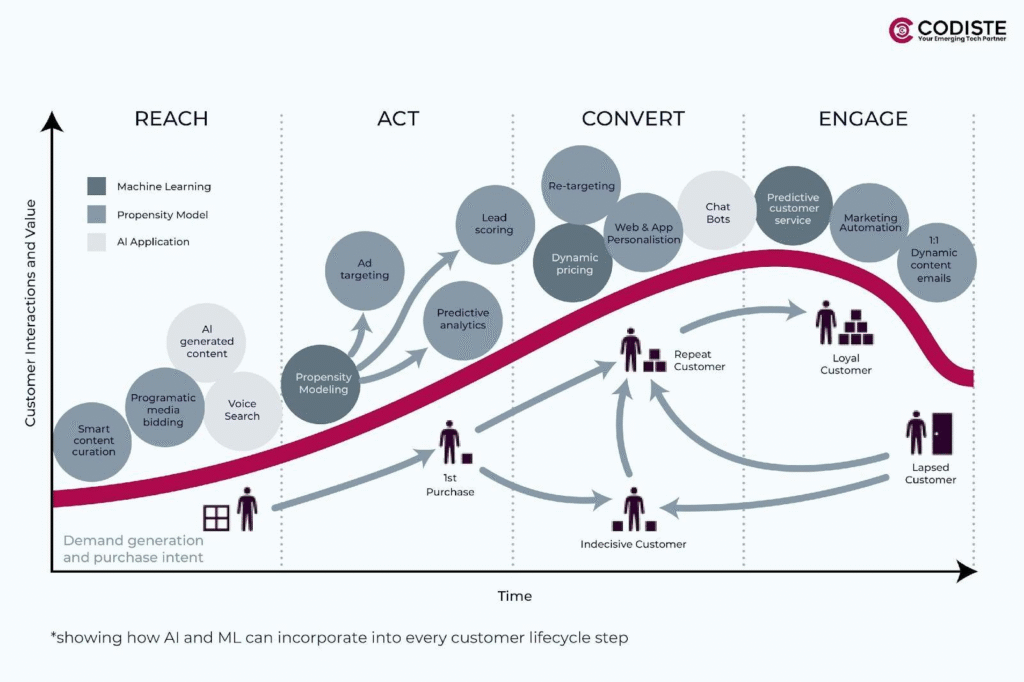
The Human-in-the-Loop Principle
While AI excels at crunching numbers and spotting patterns, it isn’t a replacement for human creativity or judgment. Marketing is still about storytelling, emotional resonance, and building trust — areas where people thrive.
That’s why leading agencies treat AI as a collaborator, not a substitute. The human-in-the-loop model ensures:
- Creativity remains central: Humans provide the strategic direction and creative spark that AI cannot replicate.
- Bias is managed: Teams audit and refine AI models to avoid skewed targeting or misinterpretation of data.
- Ethics are upheld: Marketers oversee how AI uses customer data, balancing personalization with privacy.
Agencies that combine AI precision with human oversight find the sweet spot — campaigns that are both data-driven and authentically creative.
Why This Matters for Agencies Today
Clients don’t just want automation; they want results they can see and measure. By embracing AI, agencies can:
- Deliver personalization at scale without ballooning costs.
- Reduce inefficiencies in workflows, freeing teams to focus on strategy.
- Prove campaign impact with data-backed ROI.
Agencies that embrace AI now are setting themselves apart in a crowded market where speed, personalization, and measurable growth define the winners.
Core AI Technologies in Marketing
Not all AI is created equal. For marketing agencies, the technologies that matter most are the ones that directly enhance personalization, campaign performance, and ROI. Below are the core areas where AI is reshaping how agencies deliver value.
Natural Language Processing (NLP)
NLP powers AI’s ability to understand and generate human-like text. For agencies, it fuels:
- Chatbots and virtual assistants that handle client or customer queries.
- Content generation for blog posts, ad copy, and emails.
- Sentiment analysis to track how audiences feel about a brand across channels.
The advantage of NLP lies in its adaptability. Unlike rule-based automation, NLP can analyze context, tone, and intent — making responses feel more personal and campaigns more relevant.
Machine Learning (ML) Segmentation
Traditional segmentation grouped audiences by static factors like age or location. ML segmentation goes deeper by analyzing behavioral data such as browsing patterns, dwell time, or purchase recency.
This enables agencies to:
- Cluster audiences dynamically based on live signals.
- Identify micro-segments that were previously invisible.
- Target campaigns with higher precision, driving better conversion rates.
McKinsey has reported that companies using AI-driven segmentation see notable increases in customer retention compared to those relying on manual methods.
Predictive Analytics
Predictive analytics uses historical and live data to forecast outcomes. For agencies, it helps:
- Forecast campaign performance before launching.
- Reallocate budgets dynamically across underperforming and high-performing channels.
- Identify high-value leads with propensity scoring.
For example, Deloitte found that predictive models can reduce cost-per-acquisition (CPA) by over 20% by optimizing spend allocation.
Retrieval-Augmented Generation (RAG)
RAG is one of the most exciting innovations in marketing AI. It combines generative models with live data retrieval, ensuring outputs are both creative and factually accurate.
For agencies, RAG enables:
- Real-time personalization: content that adapts based on the latest customer signals.
- Up-to-date accuracy: avoiding outdated or irrelevant information in campaigns.
- Scalable relevance: adapting messaging across different markets or segments instantly.
Agencies using RAG-based systems like CustomGPT.ai have seen improved engagement and campaign trust because every AI-generated message is backed by current data.
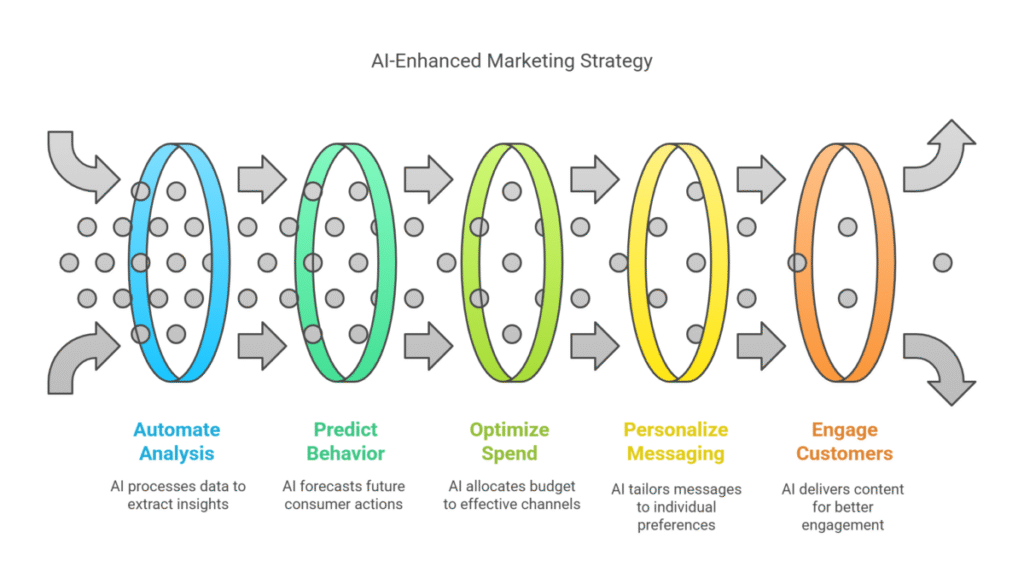
AI in Agency Workflows
Adopting AI in a marketing agency isn’t just about using new tools — it’s about reshaping workflows so teams can work smarter, not harder. When integrated properly, AI becomes the engine behind efficiency, agility, and creative focus.
Workflow Automation
One of the biggest gains comes from automation. AI takes on repetitive, time-intensive tasks so teams can concentrate on strategy and creativity. Examples include:
- Automated reporting: Campaign dashboards that update in real time.
- Content scheduling: AI tools posting across channels at optimal times.
- Behavioral triggers: Emails, ads, or offers sent instantly based on user actions.
Agencies adopting workflow automation report significant reductions in manual work, often freeing up 30–40% of staff time.
Predictive Insights in Daily Operations
AI also enhances decision-making at the operational level. With predictive analytics embedded in workflows, agencies can:
- Forecast campaign performance before budgets are spent.
- Reallocate ad spend dynamically to high-performing channels.
- Optimize email lists and targeting to improve conversions.
This turns workflows from reactive processes into proactive systems, allowing agencies to act on insights before problems arise.
Collaboration with Human Creativity
A common misconception is that AI will replace human marketers. In reality, it enables teams to do more of what humans excel at: creativity, strategy, and storytelling.
Agencies that thrive with AI ensure collaboration looks like this:
- AI handles data-heavy tasks like trend analysis and segmentation.
- Humans provide direction by shaping narratives, brand voice, and campaign vision.
- Feedback loops refine AI outputs, ensuring alignment with client goals.
When humans and AI collaborate, agencies deliver campaigns that are both efficient and emotionally resonant — the best of both worlds.
Campaign Efficiency and Data-Driven Management
Efficiency is the lifeblood of marketing agencies. Clients expect results faster, across more channels, and with clearer ROI than ever before. AI solutions enable agencies to meet those expectations by combining automation with advanced data-driven management.
AI-Powered Automation
AI-driven automation ensures campaigns adapt in real time, without requiring constant manual oversight. Key applications include:
- Behavioral triggers: Ads, emails, or offers that respond instantly to user actions like clicks, purchases, or abandoned carts.
- Personalized sequences: Nurture flows that adjust dynamically based on engagement.
- Smart scheduling: Campaigns launched when audiences are most likely to engage.
Multi-Touch Attribution
Traditional last-click attribution often undervalues the impact of earlier touchpoints. AI solves this by analyzing the entire customer journey.
- Multi-touch attribution models assign weight to each step — from ad impression to email click to final conversion.
- Agencies gain a truer picture of ROI, avoiding underinvestment in awareness-building or retargeting campaigns.
- Budget allocation becomes more precise, reducing wasted spend.
Proactive Campaign Management
Perhaps the biggest shift AI brings is moving agencies from reactive to proactive management.
- Scenario simulations: Predict outcomes before launching campaigns.
- Dynamic budget reallocation: Shift spend mid-campaign to maximize performance.
- Micro-trend detection: Spot niche audience behavior in real time and adjust messaging.
Instead of waiting weeks for results, agencies can optimize continuously, delivering stronger outcomes with greater speed.
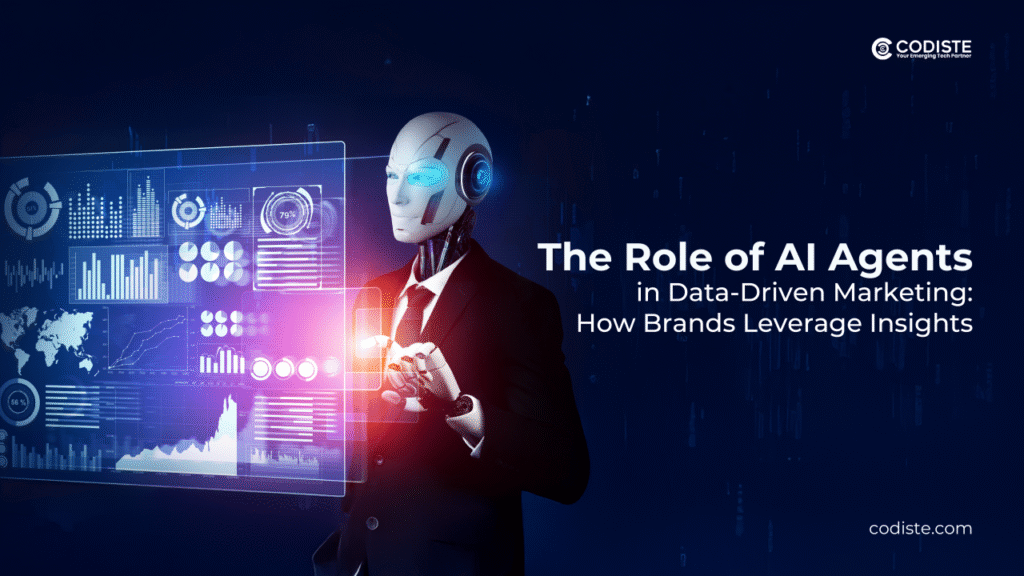
Tools and Platforms Agencies Use
The right AI platforms make the difference between experimenting with automation and building client-ready solutions that scale. For agencies, tool selection is as much about integration and ROI as it is about features.
Here are some of the most widely used and agency-relevant platforms.
CustomGPT.ai
CustomGPT.ai combines natural language processing with retrieval-augmented generation (RAG), enabling agencies to build accurate, context-aware AI assistants without code.
- No-code platform supporting over 1,400 file formats, with social, CMS, and CRM integrations.
- Pretrained on official AI models with live data retrieval (RAG), citations, and hallucination prevention.
- Enterprise-grade security, multilingual support (92 languages), and APIs for seamless embedding.
Jasper AI
Jasper AI helps agencies scale content production with quality and brand consistency:
- A broad selection of templates for emails, blogs, ads, and more.
- Brand-voice customization, multi-language support, and SEO optimization tools.
- A “Boss Mode” that enables fast long-form drafting on demand.
SurferSEO
SurferSEO helps agencies speed up and improve SEO content creation by offering:
- A content editor with live content scoring based on top-ranking pages.
- A SERP analyzer, content audit, and keyword research for data-driven optimization.
- Automated internal link insertion and plagiarism checking.
AdCreative.ai
Creative testing is a constant challenge for agencies. AdCreative.ai helps agencies optimize ad creation and performance testing with:
- AI-powered design that generates ad visuals and text in seconds.
- A library of templates with customizable branding.
- Built-in A/B testing to identify top-performing creatives automatically.
For paid media teams, this means more effective campaigns with less manual trial-and-error.
Google Analytics 4 (GA4)
GA4 integrates predictive analytics with cross-channel measurement, giving agencies:
- A unified view of the customer journey.
- Predictive insights into which audiences are most likely to convert.
- Real-time tracking to guide campaign adjustments mid-flight.
When combined with creative and personalization tools, GA4 ensures agencies not only launch campaigns but also measure and refine ROI continuously.
Building Custom Models
While off-the-shelf AI tools deliver value, many agencies eventually consider building custom models. The reason is simple: generic systems can’t always capture the nuances of a client’s brand, audience, or industry.
Custom models allow agencies to fine-tune performance, achieve higher precision, and differentiate their offerings.
Fine-Tuning vs. Building from Scratch
Agencies face a key decision when developing AI models:
- Fine-tuning pre-trained models
- Faster and less resource-intensive.
- Leverages existing architectures like GPT or BERT.
- Best for agencies needing customization without massive infrastructure.
- Building from scratch
- Provides maximum flexibility and control.
- Allows for niche applications that pre-trained models can’t handle.
- Requires significant investment in data, engineering, and compute power.
Most agencies find fine-tuning the smarter first step, with full custom builds reserved for highly specialized use cases.
Preparing Data for Accuracy
No matter the approach, data quality makes or breaks the model. Agencies must:
- Clean and normalize datasets to avoid inconsistencies.
- Label and structure data for clarity.
- Audit for bias, ensuring representation across demographics and behaviors.
For example, agencies training recommendation systems on clean, standardized customer interaction logs often see double-digit improvements in output accuracy compared to those using raw, unprocessed data.
Scaling Models Across Campaigns
A model that works for one client isn’t automatically scalable. To roll out custom AI effectively, agencies should:
- Develop shared architectures that adapt across multiple clients.
- Build in role-based access controls to protect sensitive client data.
- Centralize deployment on platforms that unify workflows and reporting.
This approach ensures custom models don’t stay siloed but instead become repeatable assets that drive efficiency and ROI agency-wide.
Optimizing Campaigns with AI
Once AI is embedded into agency workflows, the next step is optimization. AI doesn’t just automate existing processes — it actively improves campaigns in real time, ensuring better targeting, stronger engagement, and higher ROI.
Predictive Budget Allocation
Campaign budgets are one of the most dynamic levers in marketing. AI-powered predictive analytics helps agencies:
- Forecast performance of different channels before allocating spend.
- Reallocate budgets mid-campaign to maximize results.
- Reduce wasted spend by identifying underperforming ads early.
Dynamic Content Adaptation
Relevance drives engagement. AI enables agencies to adapt messaging in real time by:
- Analyzing user actions like clicks, scroll depth, or cart abandonment.
- Adjusting content and creatives instantly to fit context.
- Delivering hyper-relevant offers at the exact moment of intent.
Platforms like CustomGPT.ai specialize in dynamic personalization, tailoring campaign copy to reflect real-time customer behavior, which agencies report leads to higher engagement and lower bounce rates.
Hyper-Personalization and Segmentation
Traditional segmentation relied on broad categories like age or geography. AI enables behavioral clustering that groups audiences by nuanced actions, such as browsing sequences or purchase timing.
With hyper-personalization, agencies can:
- Deliver one-to-one messaging at scale.
- Refine offers based on lifetime value predictions.
- Improve loyalty and retention by continuously adapting to changing behaviors.
This level of precision is becoming a client expectation, not just a competitive advantage — and agencies that can deliver it stand out in a crowded market.
Measuring ROI of AI-Powered Marketing
For agencies, ROI isn’t just a performance metric — it’s the currency of trust. Clients want to see how investments in AI translate into real-world outcomes.
Measuring ROI requires going beyond clicks and impressions to include financial impact, operational efficiency, and predictive accuracy.
Financial Metrics
The most direct measures of ROI are financial outcomes. Agencies can track:
- Cost per acquisition (CPA): lower CPA indicates more efficient targeting.
- Return on ad spend (ROAS): shows how much revenue is generated for every ad dollar spent.
- Customer lifetime value (CLV): highlights long-term revenue from AI-driven retention strategies.
These metrics give clients the clearest picture of AI’s financial contribution.
Operational Metrics
AI’s impact isn’t always purely financial — it also transforms how agencies work. Operational metrics reveal these efficiency gains:
- Speed-to-decision: Time saved in campaign testing and optimization.
- Cycle reduction: Faster A/B testing and quicker adjustments.
- Error reduction: Fewer manual mistakes thanks to AI-powered automation.
Advanced Metrics
To capture AI’s unique value, agencies should also track advanced indicators such as:
- Uplift over control: the incremental gains AI adds compared to traditional methods.
- Mean absolute percentage error (MAPE): accuracy of AI forecasts against actual outcomes.
- Engagement depth: metrics like dwell time or scroll depth that show improved personalization.
Why ROI Measurement Matters for Agencies
By showing not only how AI improves revenue but also how it saves time, reduces errors, and increases agility, agencies can prove that AI is more than a buzzword — it’s a client growth driver. This evidence-based approach helps agencies retain clients, win new accounts, and justify larger budgets for innovation.
Future Trends and Challenges in AI Marketing
AI in marketing is evolving quickly, and agencies that anticipate the next wave of innovation will be better positioned to stay ahead of client expectations.
At the same time, new technologies bring new challenges around accountability, scalability, and ethics.
Context-Aware Automation
The next generation of automation isn’t just responsive — it’s context-aware. Campaigns can now adjust based on external signals like weather, location, or live events.
- Retailers can trigger local promotions during unexpected weather changes.
- Entertainment brands can launch social campaigns tied to trending events.
- Travel companies can adapt offers to shifts in booking demand.
According to Gartner, brands using context-aware automation have seen significant boosts in engagement during region-specific promotions.
Multimodal AI
Marketing is no longer about a single channel or format — it’s about experiences that blend text, images, video, and even voice.
Multimodal AI can:
- Generate consistent creative assets across different media.
- Align messaging across written, visual, and audio touchpoints.
- Power more immersive campaigns that feel seamless to the end user.
This is especially relevant as agencies manage increasingly fragmented customer journeys.
Accountability and Explainability
As AI systems become more autonomous, transparency is becoming a non-negotiable requirement. Agencies must ensure:
- Audit trails exist for decisions like ad targeting or budget shifts.
- Explainable AI (XAI) is in place to show clients and regulators how decisions were made.
- Bias checks and fairness audits are performed regularly to maintain trust.
The Balancing Act for Agencies
Future trends highlight both the promise and the pressure. Agencies that master context-aware, multimodal, and transparent AI will lead in client acquisition and retention.
Those that fail to address these challenges risk losing trust — and ultimately, business.
Emerging AI Technologies and Their Potential
AI gives agencies unprecedented power to personalize campaigns and optimize results — but with that power comes responsibility. Ethical deployment isn’t just about compliance; it’s about protecting brand trust, client relationships, and long-term viability.
Bias Mitigation
AI models are only as good as the data they are trained on. If datasets lack diversity or are skewed toward certain demographics, the outputs can reinforce bias. For agencies, this means campaigns risk unintentionally excluding or misrepresenting groups.
Key actions for agencies:
- Audit datasets for diversity and representation.
- Use techniques like adversarial debiasing, where models are trained to ignore sensitive attributes (e.g., gender or geography) while focusing on behavior-driven signals.
- Perform regular fairness checks to ensure outputs align with ethical and brand values.
Transparency
Clients increasingly demand clarity about how AI-driven campaigns work. Transparency is no longer a “nice to have” — it’s a differentiator.
Best practices include:
- Using explainable AI (XAI) frameworks to show how outputs were generated.
- Providing audit-ready documentation that tracks decisions and recommendations.
- Being clear with clients about which campaign elements are AI-driven and which are human-led.
By embedding explainability, agencies not only comply with regulations like the EU AI Act but also strengthen client confidence.
Privacy and Compliance
Marketing relies heavily on personal data — making compliance essential. With regulations like GDPR and CCPA expanding globally, agencies must ensure AI systems respect privacy at every step.
Steps to take:
- Implement consent management systems that align with local laws.
- Minimize data collection, keeping only what’s necessary.
- Embed privacy-preserving techniques such as differential privacy or data anonymization.
Agencies that demonstrate compliance readiness don’t just avoid penalties — they position themselves as trusted stewards of customer data, an increasingly valuable differentiator.
FAQs
How can marketing agencies use AI?
Agencies can apply AI throughout their services — from generating content and optimizing SEO to managing ad spend and tracking campaign performance. It supports personalization, automates repetitive tasks, and strengthens decision-making with data-driven insights.
What AI tools are best for marketing agencies?
The best tools depend on your agency’s focus, but popular choices include:
CustomGPT.ai for personalization and client-facing assistants.
Jasper AI for ad copy and branded content.
SurferSEO for keyword research and content optimization.
AdCreative.ai for automated ad design and testing.
Google Analytics 4 (GA4) for predictive insights and reporting.
How does AI improve marketing agency results?
AI improves results by helping agencies:
Launch campaigns faster.
Reduce acquisition costs.
Target audiences more precisely.
Measure ROI with greater accuracy.
What’s the ROI of AI for marketing agencies?
Agencies see ROI in two main ways:
Financial impact through higher conversions, better ad spend efficiency, and improved customer lifetime value.
Operational impact through faster workflows, fewer manual tasks, and quicker access to insights.
How to implement AI in marketing agency workflows?
The best approach is phased:
Start with a pilot tied to specific KPIs.
Connect AI with your existing tools and data pipelines.
Train your team to work alongside AI.
Expand use cases gradually across more services and clients.
Monitor and refine continuously.
Conclusion
AI is no longer a side tool for marketing agencies — it’s the foundation for delivering personalization at scale, optimizing budgets in real time, and proving ROI with clarity.
Agencies that adopt AI today gain a decisive edge: they work smarter, serve clients better, and create new growth opportunities that set them apart from competitors still relying on manual workflows.
But success with AI isn’t just about choosing the right technology — it’s about embedding it into processes, aligning it with client goals, and scaling it across services. Agencies that master this integration will not only meet client expectations but consistently exceed them.
Ready to Take Action?
If you’re ready to take the next step, consider becoming part of the CustomGPT.ai Solution Partner Program.
As a partner, you’ll gain access to certified frameworks, expert resources, and support that helps agencies implement AI faster, with higher adoption and measurable results.
The future of marketing is AI-powered. The agencies leading that future are the ones building with it today.



